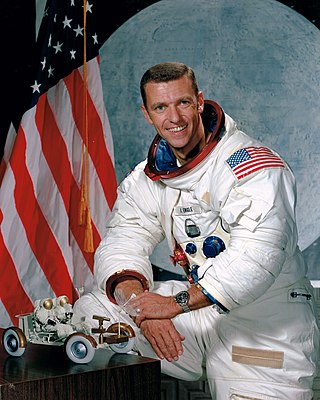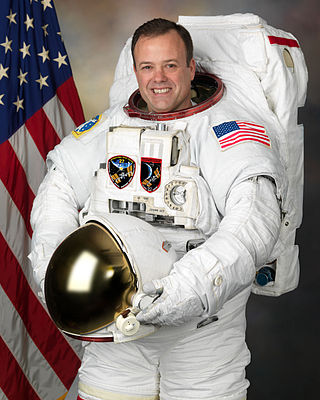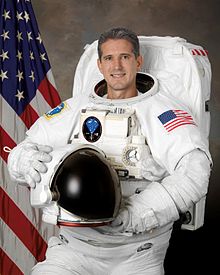
Francis Richard "Dick" Scobee was an American pilot, engineer, and astronaut. He was killed while commanding the Space Shuttle Challenger in 1986, which suffered catastrophic booster failure during launch of the STS-51-L mission.

Paul Scott "Paco" Lockhart is an American aerospace engineer, retired United States Air Force colonel and NASA astronaut, a veteran of two Space Shuttle missions.

Richard Michael Mullane is an engineer and weapon systems officer, a retired USAF officer, and a former NASA astronaut. During his career, he flew as a mission specialist on STS-41-D, STS-27, and STS-36.

Karol Joseph "Bo" Bobko was an American aerospace engineer, U.S. Air Force officer, test pilot, and a USAF and NASA astronaut. Bobko was the first graduate of the U.S. Air Force Academy to travel in space and the first person to fly on a space shuttle on three different missions: STS-6, STS-51-D, STS-51-J.

Joe Henry Engle was an American pilot, aeronautical engineer, and NASA astronaut. He was the commander of two Space Shuttle missions including STS-2 in 1981, the program's second orbital flight. He also flew two flights in the Shuttle program's 1977 Approach and Landing Tests. Engle was one of twelve pilots who flew the North American X-15, an experimental spaceplane jointly operated by the Air Force and NASA.

Donald Herod Peterson was a United States Air Force officer and NASA astronaut. Peterson was originally selected for the Air Force Manned Orbiting Laboratory (MOL) program, but, when that was canceled, he became a NASA astronaut in September 1969. He was a mission specialist on STS-6 on board Challenger. During the mission Peterson performed a spacewalk to test the new airlock and space suits. He logged 120 hours in space. Peterson retired from NASA in 1984.

John McCreary Fabian is a former NASA astronaut and Air Force officer who flew two Space Shuttle missions and worked on the development of the Shuttle's robotic arm. He later led the Air Force's space operations.

Duane Gene "Digger" Carey is a retired lieutenant colonel in the United States Air Force and a former NASA astronaut. He piloted the space shuttle Columbia on March 1, 2002, during a Hubble Space Telescope servicing mission.

Ronald John Grabe, , is a former NASA astronaut.

Lloyd Blaine Hammond Jr. is a Gulfstream test pilot, a former United States Air Force officer, and a former NASA astronaut. He flew on two Space Shuttle missions.

Guy Spence Gardner is a United States Air Force officer and a former astronaut. He holds the rank of colonel. He flew as pilot on two Space Shuttle missions, STS-27 and STS-35. Gardner was also the 12th president of the Williamson College of the Trades.

Steven Wayne Lindsey is a retired U.S. Air Force officer and NASA astronaut. Lindsey served as Chief of the NASA Astronaut Office from September 2006 until October 2009.

Steven Ray Nagel, , was an American astronaut, aeronautical and mechanical engineer, test pilot, and a United States Air Force pilot. In total, he logged 723 hours in space. After NASA, he worked at the University of Missouri College of Engineering as an instructor in its Mechanical and Aerospace Engineering Department.

Richard Alan "Rick" Searfoss was an American aviator who was United States Air Force colonel, NASA astronaut and test pilot.

Rex Joseph Walheim is a retired United States Air Force officer, engineer and NASA astronaut. He flew three Space Shuttle missions, STS-110, STS-122, and STS-135. Walheim logged over 566 hours in space, including 36 hours and 23 minutes of spacewalk (EVA) time. He was assigned as mission specialist and flight engineer on STS-135, the final Space Shuttle mission.

Eric Allen Boe is a retired United States Air Force fighter pilot, Colonel, test pilot, and a current, active NASA astronaut. He flew as the pilot of Space Shuttle missions STS-126 and STS-133.

Kevin Anthony Ford is a retired United States Air Force Colonel and NASA astronaut. Ford has received a number of special honors and awards, some of which are the Air Force Meritorious Service Medal, Air Force Commendation Medal, Aerial Achievement Medal and the Armed Forces Expeditionary Medal. Ford has also logged more than 6,100 flying hours and also holds FAA certificates for airplanes, helicopters, gliders, and balloons. Ford has served in many roles at NASA since his selection in July 2000. The roles include as a Capsule Communicator or CAPCOM. He was also the Director Of Operations at the Gagarin Cosmonaut Training Center in Star City, Russia from January 2004 to January 2005. He was pilot of STS-128 and flight engineer 2 of Soyuz TMA-06M from October 23, 2012, to March 16, 2013. He served as ISS flight engineer for Expedition 33, and commander of Expedition 34.

Ronald John Garan Jr. is a retired NASA astronaut. After graduating from State University of New York College at Oneonta in 1982, he joined the Air Force, becoming a Second Lieutenant in 1984. He became an F-16 pilot, and flew combat missions in Desert Shield and Desert Storm. Before becoming an astronaut he was the Operations Officer of the 40th Flight Test Squadron (FTS). He first flew in space as a mission specialist on the May 2008 STS-124 mission to the International Space Station (ISS). He returned to ISS on April 4, 2011, for a six-month stay as a member of Expedition 27. Garan is a highly decorated former NASA astronaut who flew on the US Space Shuttle, Russian Soyuz, and International Space Station. In total he spent 178 days in space and more than 71 million miles in 2,842 orbits of Earth, 27 hours and 3 minutes of EVA in four spacewalks, and 18 days on the bottom of the ocean during the NEEMO-9 undersea mission.

Robert Louis Behnken is an American engineer, a former NASA astronaut, and former Chief of the Astronaut Office.

Benjamin Alvin Drew Jr. is a United States Air Force officer and a former NASA astronaut. He has been on two spaceflights; the first was the Space Shuttle mission STS-118 to the International Space Station, in August 2007. Drew's second spaceflight took place in March 2011 on STS-133, another mission to the International Space Station. STS-133 was Space Shuttle Discovery's final mission. Drew took part in two spacewalks while docked to the station. Drew was the final African-American to fly on board a Space Shuttle, as the final two Space Shuttle missions, STS-134 and STS-135, had no African-American crew members.




















